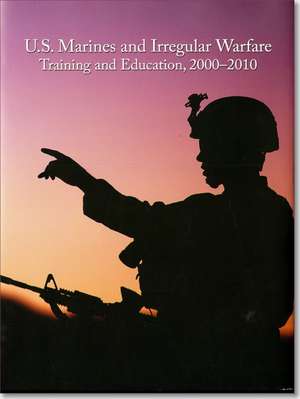U.S. Marines and Irregular Warfare, Training and Education, 2000-2010
Autor Nicholas J. Schlosser Editat de Marine Corps (U.S.), History Divisionen Limba Engleză Hardback – 29 iun 2015 – vârsta până la 95 ani
U.S.
Marines
in
Irregular
Warfare:
Training
and
Education
is
a
brief
history
that
recounts
how
the
U.S.
Marine
Corps
adapted
to
fight
the
Global
War
on
Terrorism
during
2000–10.
The
Marine
Corps
has
a
long
history
of
fighting
irregular
wars,
including
the
Banana
Wars
in
Central
America
during
the
1920s
and
the
Vietnam
War
during
the
1960s.
To
battle
the
insurgencies
in
Iraq
and
Afghanistan,
the
Corps
drew
upon
this
experience
while
also
implementing
new
plans
and
programs
to
better
prepare
Marines
to
carry
out
counterinsurgency
operations.
The
Marine
Corps
updated
the
curriculum
at
the
Command
and
Staff
College
and
transformed
the
annual
Combined
Arms
Exercise
into
Exercise
Mojave
Viper:
an
immersive
training
program
that
simulated
the
urban
environments
in
which
Marines
would
be
operating
in
Southwest
Asia.
Most
importantly,
Marines
adjusted
in
the
field,
as
battalion
and
company
commanders
drew
on
their
basic
training
and
education
to
devise
innovative
tactics
to
better
combat
the
new
threats
they
now
faced.
?us,
as
this
story
shows,
the
Marine
Corps
did
not
undergo
a
radical
transformation
to
fight
in
Iraq
and
Afghanistan,
but
instead
drew
on
principles
that
had
defined
it
as
a
warfighting
organization
throughout
most
of
its
history.
Keywords: United States Marine Corps; United States Marines; U.S. Marine Corps; U.S. Marines; Marines; Marine Corps; Global War on Terrorism; global war on terrorism; irregular warfare; military strategy; counterinsurgency; combat; iraq war; Iraq War; Afghanistan; military education; soldier training; combat training and tactics; Southwest Asia
Keywords: United States Marine Corps; United States Marines; U.S. Marine Corps; U.S. Marines; Marines; Marine Corps; Global War on Terrorism; global war on terrorism; irregular warfare; military strategy; counterinsurgency; combat; iraq war; Iraq War; Afghanistan; military education; soldier training; combat training and tactics; Southwest Asia
Preț: 346.98 lei
Nou
Puncte Express: 520
Preț estimativ în valută:
66.45€ • 68.47$ • 55.67£
66.45€ • 68.47$ • 55.67£
Carte indisponibilă temporar
Doresc să fiu notificat când acest titlu va fi disponibil:
Se trimite...
Preluare comenzi: 021 569.72.76
Specificații
ISBN-13: 9780160927836
ISBN-10: 0160927838
Pagini: 130
Ilustrații: Illustrated, some color
Dimensiuni: 222 x 286 x 13 mm
Greutate: 0.84 kg
Editura: United States Dept. of Defense
Colecția Dept. of the Navy
ISBN-10: 0160927838
Pagini: 130
Ilustrații: Illustrated, some color
Dimensiuni: 222 x 286 x 13 mm
Greutate: 0.84 kg
Editura: United States Dept. of Defense
Colecția Dept. of the Navy
Notă biografică
About
the
Author
Nicholas J. Schlosser is a historian at the U.S. Army Center of Military History. Between 2009 and 2014, Dr. Schlosser worked at the Marine Corps History Division, where he researched and wrote about irregular warfare, the Iraq War, and the Vietnam War. He received his doctorate in history from the University of Maryland, College Park, in 2008.
Nicholas J. Schlosser is a historian at the U.S. Army Center of Military History. Between 2009 and 2014, Dr. Schlosser worked at the Marine Corps History Division, where he researched and wrote about irregular warfare, the Iraq War, and the Vietnam War. He received his doctorate in history from the University of Maryland, College Park, in 2008.
Cuprins
Table
of
Contents
Foreword ...........................................................................................v
Preface ............................................................................................. vii
Introduction ......................................................................................1
Chapter 1 ...........................................................................................7
A Heritage of Fighting Small Wars:
The Marine Corps and Irregular Warfare, 1900–1990
Chapter 2 ......................................................................................... 25
Marine Corps Warfighting Concepts from 1991 to 2002
Chapter 3 ......................................................................................... 43
The Iraq War
Chapter 4 ......................................................................................... 63
The Marine Corps Rediscovers Counterinsurgency
Chapter 5 ......................................................................................... 81
Adapting Marine Corps Combat Units to Counterinsurgency:
Training in the United States and Adapting in the Field
Conclusion ...................................................................................... 97
Notes ............................................................................................. 101
Index.............................................................................................. 115
Foreword ...........................................................................................v
Preface ............................................................................................. vii
Introduction ......................................................................................1
Chapter 1 ...........................................................................................7
A Heritage of Fighting Small Wars:
The Marine Corps and Irregular Warfare, 1900–1990
Chapter 2 ......................................................................................... 25
Marine Corps Warfighting Concepts from 1991 to 2002
Chapter 3 ......................................................................................... 43
The Iraq War
Chapter 4 ......................................................................................... 63
The Marine Corps Rediscovers Counterinsurgency
Chapter 5 ......................................................................................... 81
Adapting Marine Corps Combat Units to Counterinsurgency:
Training in the United States and Adapting in the Field
Conclusion ...................................................................................... 97
Notes ............................................................................................. 101
Index.............................................................................................. 115
